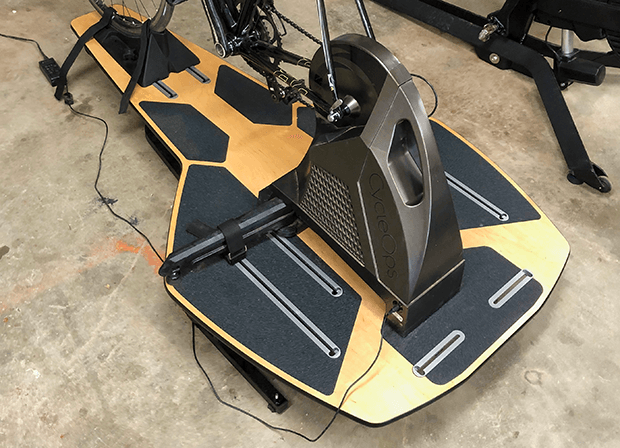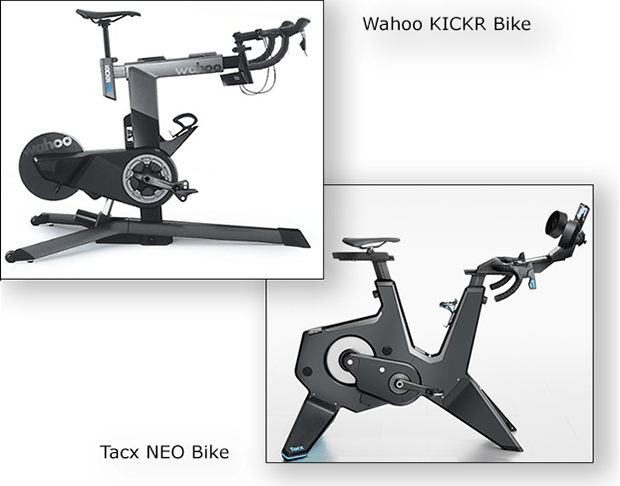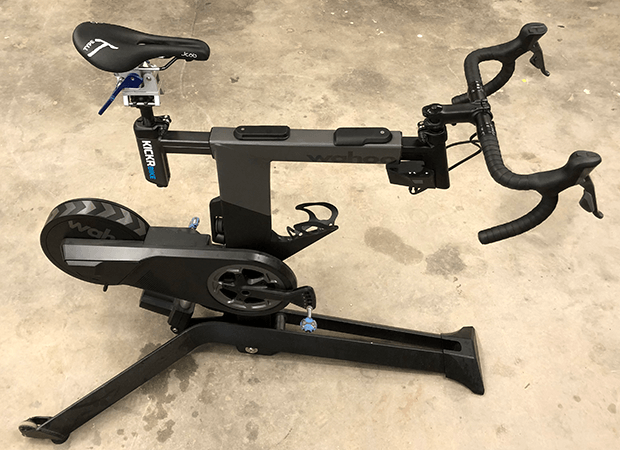To Erg Or Not To Erg
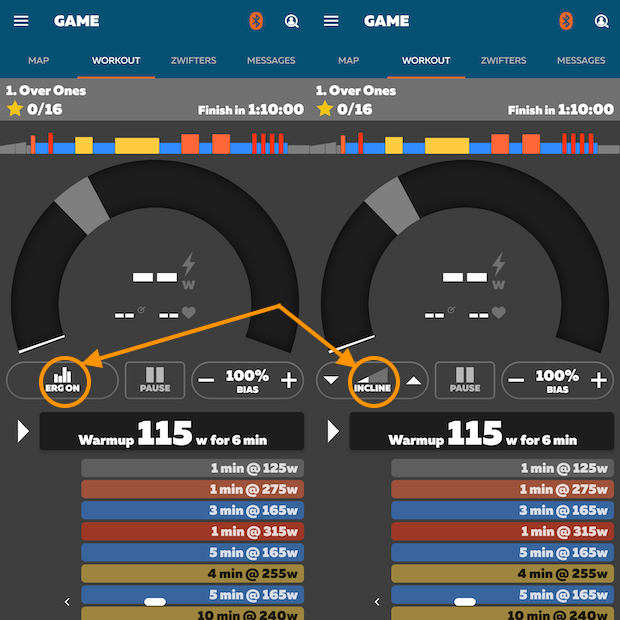
[Author's note: I originally wrote this piece internally for Zwift, but it seemed a bit too technical. I think that makes it perfect for Slowtwitch. However, it should be noted that I work for Zwift, and that's why it's so Zwift-centric. But Erg Mode is not at all unique to Zwift. Virtually all major training platforms will support this. As do most good headunits that can control a smart trainer. I just don't use those other platforms. But from a "when/how/should I use ERG mode?" perspective, the Zwift aspect of this is entirely irrelevant. I have my obvious biases, but Erg Mode is by no means a special or unique feature.
I wrote this about the same time that this thread – "Why you need to quit ERG mode…" – appeared on our forum. I didn't write it in response that thread; it was just a happy coincidence. This is the much longer version of the answer I gave in there.]
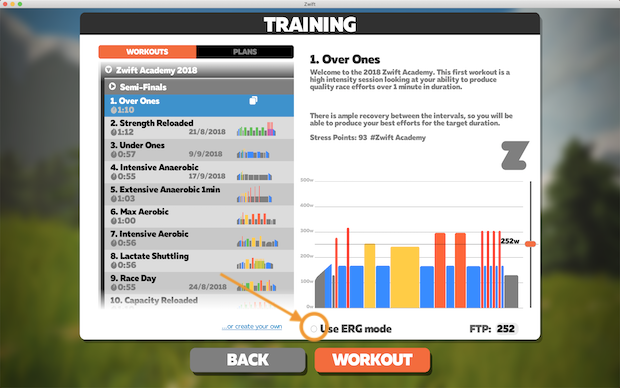
Erg Mode – available when using Zwift in Workout Mode with a compatible "smart" trainer – means that the trainer will adjust the resistance the trainer applies in order to help maintain the prescribed power of a given interval. Erg mode is a reference to the CGS unit of energy – the Erg – which is 10-7 joules or, approximately, the amount of energy used by a common house-fly to do a push-up.
Humans generate power on a bicycle by applying a force to the pedals. Because the pedal is at the end of the crank – a lever-arm – this force generates a torque which drives the system via the chain and sprocket. There are two ways to generate more power, which is defined as a unit of work within a period of time. You can either apply more force in order to do more work – pedal harder – or you can decrease the unit of time it takes to complete that unit of work – pedal faster. Erg Mode works by adjusting the resistance up as your cadence drops – meaning you need to generate more force – or by decreasing the resistance as your cadence increases – because you are doing your work more quickly.
How rapidly this change happens varies from trainer to trainer, and is somewhat limited by how often Zwift and the trainer communicate. Zwift also does some work behind the scenes to smooth things out and to keep the changes from being too drastic in one direction or another. For this reason, Erg Mode often is not a great choice for workouts with a lot of very short and very big changes in power. But good smart trainers respond quite quickly, and I find that Erg Mode works well for intervals as short as 20 seconds; anything shorter than that and you probably will want to take care of things yourself by shifting and how hard you pedal.
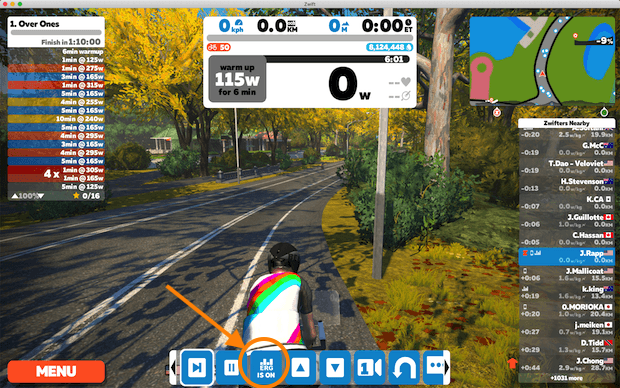
Erg Mode is the default option for Workout Mode in Zwift, so if you've never actually paid attention to whether or not Erg Mode was on or not, you may have been using it this whole time without ever knowing. For most typical workouts – things like SST or The MCarthy Special, Erg Mode works just fine. As with (almost) every approach to training, there are those who insist that it has no place in "proper" training and those who insist it's the only way to train indoors. Again, as with most every approach to training, the truth is somewhere in between.
The "opposite" of Erg Mode in Zwift is Incline Mode; Incline Mode allows you to manually set the resistance of the trainer to be as hard – or as easy – as you wish. When you're just riding around in Zwift not doing a workout, you are in Sim – or Simulation – Mode, where Zwift is telling the trainer what the gradient is of the road that you're on (or, more precisely, the gradient of the road you will be on by the time the trainer gets the message Zwift is sending). If you turn Erg Mode to Off using Zwift Companion or the blue Control Strip, you'll see another set of Up/Down arrow buttons appear; these allow you to increase or decrease the resistance of the trainer (shown as an orange, vertical analog scale to the right of the HUD). When Erg Mode is On, the trainer will change its resistance automatically based on the target power of the given block. (If you're in a Free Ride block, you will almost always be placed into Incline mode unless your coach or the workout author has set it up to preserve the terrain of Zwift.) Neither Erg Mode nor Incline Mode is either "better" or "worse." And to the larger point, doing formal, structured workouts is also not better or worse training than riding around or racing. The key is using the tools at your disposal to help you achieve the training stimulus you are seeking.
Erg Mode is simply another tool to put in your training toolkit. For a lot of people, Erg Mode is just simpler, because it does a lot of the thinking for you. If you like to just tune out – especially during very long blocks – Erg Mode is great. But just thinking of it as a way to make it easier to think less is to shortchange all the ways that it can impact your training. I really started thinking more about how – and when – to use Erg Mode when I switched from being a triathlete – where the training is pretty monotonous, generally long, and fairly steady. Long distance triathlon cycling is, as Mark Allen liked to say, "an exercise in who can whisper the loudest." It's supposed to be very steady. That sort of training probably doesn't matter too much when it comes to Erg On or Erg Off; I'd actually say that there's a slight preference to having Erg Off because it's really important to develop the skill – and it is a skill – of pacing yourself evenly and steadily across a long period of time and – especially – across variable terrain. Cadence is also not particularly important for triathletes and, if anything, there's a preference for lower cadences where neuromuscular coordination is rarely – if ever – a limiter.
But when I started training on the track, cadence became a much more important element of performance. On the track, with a single, fixed gear, cadence and power and speed are all inextricably linked. And it was because of this that I really started to delve deep into how best to use Erg Mode.
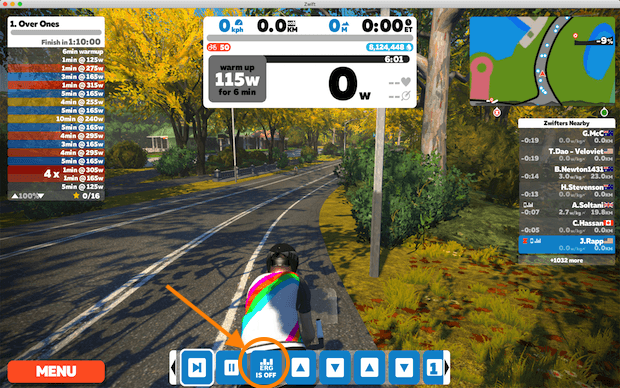
For workouts where cadence is the key parameter, use Erg Mode. If you have to focus on both the power and cadence, it's hard to do either well. If hitting a specific cadence is important – and there is compelling research that high-cadence pedaling is a specific skill that you need to train, then using Erg Mode is a great way to make sure you hit that. Interestingly, I'd say it's particularly for high-cadence workouts that Erg Mode is most beneficial; for low-cadence workouts it can go either way. For really low-cadence workouts, Erg Mode may actually be problematic because it can be easy for the resistance to spike so high as to lock the trainer up or if you spike the power even a bit the trainer resistance can drop off making it harder to stay on the cadence. Typically, for really low cadence workouts, I will use Incline Mode and just punch the resistance up to a level where I can find a good rhythm. But at high cadence – especially if the power is also high, I find that Erg Mode can really allow me to hit a cadence and power that I'd struggle to if I had to focus on both.
Many people think of Erg Mode as a tool to keep your power from dropping, but it's also at least as important as a tool to keep your power from spiking. Erg Mode is just as useful when it comes to keeping you from riding too hard as it is when it comes to keeping you from riding too easy. Especially early in a long ride or early in a high power interval where you might start with a big spike in the power, Erg Mode can be invaluable in terms of keeping a lid on your power. In particular for very high power efforts where it's very difficult to pace them evenly – you'll want to start out too hard at the beginning and want to fade at the end, Erg Mode can help to keep your pacing even. Erg Mode can also be good for keeping those of us with competitive streaks in check when someone rides by us at a time when we're supposed to be riding along at base.
On the flipside, sometimes it's important to be able to make a big surge and then settle in. Or for very short efforts where the power cannot be sustainable – like a sprint. In these cases, Erg Mode runs counter to the way that our body works, and it should not be used. Sprinting in Erg Mode is extremely counterproductive – the resistance won't be high enough at the start and will be much too high by the time your legs inevitably start to fade.
One of the major criticisms of Erg Mode is that it prevents you from learning how to pace yourself properly; but Erg Mode can actually be the single best way to teach yourself to pace evenly (which is really what people mean when they say "properly") because it helps you actually feel what it's like to maintain a steady power – especially when coupled with a target cadence. It allows you to experience something that you might struggle to understand at first. In that same way, Erg Mode can also be a great reminder to keep your power in check and to prevent too much power – something that's far more detrimental in long races than too little power – by immediately dropping the resistance if you start to spike the force on the pedals.
Ramp Blocks in Zwift also present a unique experience when coupled with Erg Mode that can be difficult – if not impossible – to replicate outdoors. By slowly ramping the power up or down, Zwift can help guide you to actually increase the power as your fatigue builds or to help you drop your power in a controlled way over the course of an interval. Controlling this precise step up or step down in power is something that can be virtually impossible to do outside because of terrain and weather. Even in Zwift, without Erg Mode, these precise ramps up – and down – are nearly impossible. This type of stimulus is something that's unique to the Ramp + Erg Mode pairing.
Especially with the introduction of Workout Mode in Zwift Companion, it's really easy to turn Erg Mode on and off and to experience the difference in how it makes a workout feel. One interesting experiment can be to do two sets of a given block of intervals spaced out with a long rest block between and to see how you feel if you do the first round with Erg Mode on and how you feel if you do the first round with Erg Mode off. But the biggest benefit will really come to thinking more about how Erg Mode can interact with different workout elements and build workouts – and engage and disengage Erg Mode within it – to put a new spin on your training. Don't just set it and forget; make how you use Erg Mode a conscious decision in your approach to structured training. For me, it has made training both more productive and more enjoyable (in that type-2 fun way).



